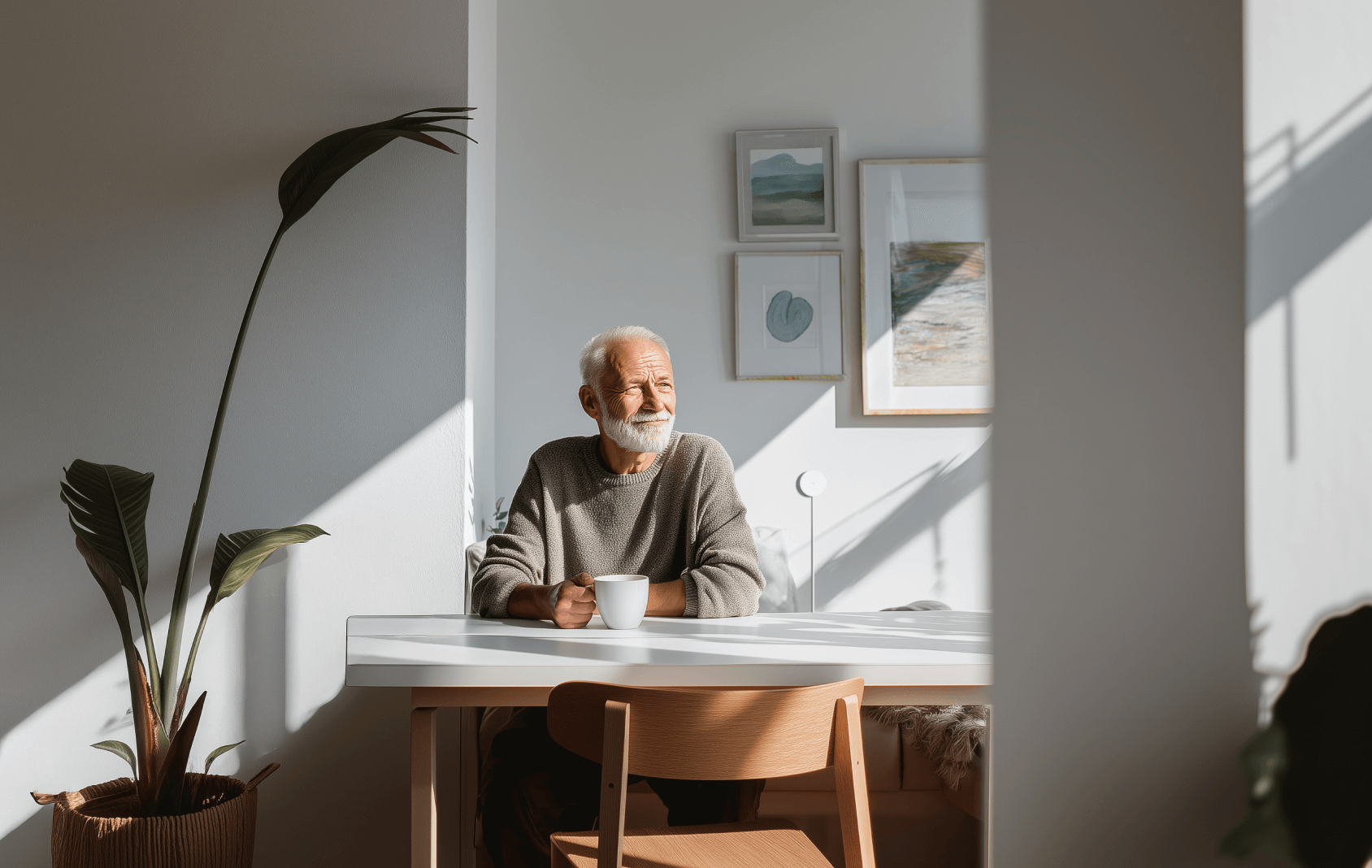Routines helps families care from afar
Density’s radar sensors power a new AI assistant for elder care, keeping caregivers up to date on their loved ones.

In a house in Yardley, Pennsylvania, a senior named Debbie has just made her way from her bedroom to the kitchen. She’ll make coffee, open the blinds and water the plants, like she does every morning. In Princeton, New Jersey her daughter just got a gentle ping on her phone: Mom’s moving through her day like usual.
This is Routines, a new AI assistant powered by Density radar sensors, not cameras. It’s designed to help families check in on aging loved ones without compromising their privacy or autonomy. And starting this fall, it’ll be available across the US.
The care gap is real and growing
The need for a solution like Routines is growing fast.
Over 61 million Americans are 65 or older. The majority want to age in place. But 44% live more than an hour away from most relatives, according to the Pew Research Center.
That leaves adult children and caregivers constantly guessing: Are they okay? Are they eating? Is the nurse or physical therapist showing up on time—or ghosting?
Whether it’s a parent living alone, or in a senior facility that promises premium care, the truth is: Staying informed is harder than it should be.
Texting isn't a strategy. Cameras are a non-starter.
Let’s be honest. The current solutions aren’t great.
Constant phone check-ins feel intrusive and unsustainable. Emergency pendants get buried in couch cushions.
And camera systems? No one wants to feel surveilled in their own home—not your parent, and not you watching grainy footage.
So we’re stuck living with low-grade worry.
Routines is designed to end that.
From workplace to home: A sensor that knows, without seeing
Routines is built on the same radar-based sensor tech that Density pioneered to track movement and occupancy in office buildings. No cameras. No microphones. Just real-time presence data, gathered passively and safely.
Yes, our radar tech is FCC-approved for home use. No, it won’t tell you what Mom is wearing. That’s the point.
“Routines can bring peace of mind when stopping by quickly isn’t an option,” says Density CEO Andrew Farah, Routines’ creator. “I’ve experienced first-hand the painful struggle between an elder’s desire to stay independent and their family members’ need to keep a closer eye as they age.”
Here's how it works: Quiet signals, big peace of mind
Routines uses the Waffle sensor, which is about the size of a drink coaster. You can stick it on a wall, plug it in and it will start building a baseline: what’s “normal” for this home?
Once it learns the rhythms, you can chat with Routines like a human assistant and it will simply answer:
- “Did Dad get up today?” “Dad woke up before 9 a.m. Everything looks normal.”
- “Was anyone with Mom this afternoon?” “Mom’s caregiver arrived at 10:02 and stayed 48 minutes.”
- “Has there been any movement this morning?” “No activity since 11 p.m. Want to check in?”
It also sends proactive nudges if something’s off: missed routines, prolonged inactivity or caregiver no-shows. It won’t try to guess or dramatize. It just tells you what it knows.
Who it’s for (and who it’s not)
Perfect for:
- Adult children who live far away or juggle caregiving for relatives with work and parenting
- Families managing in-home caregivers for their loved ones
- Partners with aging partners living in a care facility
Not designed for:
- Real-time emergency response
- Medical monitoring or video surveillance
- People who need detailed clinical data
It won’t tell you “Dad had soup.” But it will tell you he spent 24 minutes in the kitchen, then returned to the living room around noon. That’s often enough to exhale.
Join the waitlist for fall launch
You’ll need one Waffle sensor per room you want to track and most homes are covered with 3-4 sensors in the living room, kitchen and bedroom and bathroom. Setup takes just a few minutes. You don’t need to be tech-savvy to install it. No batteries or charging needed.
The full Routines system including hardware and AI assistant will be available online Fall 2025, starting at $99 per sensor and $10 per month. You can sign up now at Routines.com to join the waitlist.
Care doesn't have to be loud. Sometimes, it just looks like a text that says: “Everything seems normal today.”
Key Takeaways

DisruptCRE founder shares how corporate real estate is changing
Companies are moving employees from underutilized offices into "space as a service” options with utilization data.
Watch now
Half of offices are empty but you still can’t find a meeting room
Employees waste up to 30 minutes a day looking for a meeting room to meet in workplaces.
Read moreMost recent

Waffle: The people counter that just won a top design award
Small, smart, stylish: Discover why an occupancy sensor earned top marks at the San Francisco Design Week Awards.

Density named Workplace Analytics Innovation of the Year by the PropTech Breakthrough Awards
Density has been named as the Workplace Analytics Innovation of the Year in the 2024 PropTech Breakthrough Awards.
Read more.png)
Moving Density to in-person
Today we announced that we’re transitioning Density to an in-person company. Below is the note we shared with our team.
Read more
Unplugging productivity: The 100-minute offline experiment at our office
What happens when we disconnect to reconnect with our work and each other? Enter Airplane Mode.
Read moreExplore other Density Products
Atlas for Workplace
Insights for the workplace that help you cut costs and deliver better spaces.
Learn more